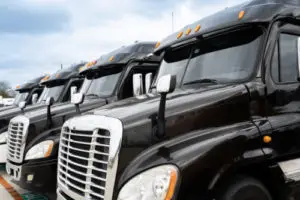
Semi-trucks carry the goods we need and want throughout Florida and throughout the nation. Semi drivers and their employers are held to higher standards than the average passenger vehicle driver, but even with more training and higher expectations, accidents still occur. Truck accidents typically result in more property damage, more severe injuries, and a higher likelihood of death for motorists and their passengers.
An understanding of what makes semis so dangerous, types and causes of semi-truck accidents, and the injuries that might stem from an accident will help you avoid causing a semi-truck accident or falling victim to an accident caused by negligent truck drivers, trucking companies, and other causes.
Dangerous Characteristics of Semi-Trucks
Semi-trucks aren’t horribly dangerous—to truckers. In fact, truck drivers involved in semi-accidents often walk away without a scratch. Yet, some of the characteristics that protect truckers can also lead to life-changing accidents for those with whom truckers share the road. The following factoids about semi-trucks should give you an idea of why you need to be cautious when sharing the road:
- Size. The average semi-truck you see traveling down the road consists of two parts: the cab, sometimes called the tractor, and the trailer. Normal size semi trailers are about 53 feet long. When you add the length of the cab, the entire semi-truck is between 70 and 80 feet long. For the sake of comparison, most passenger vehicles are between 14 and 18 feet long. Even the biggest SUVs, such as a Cadillac Escalade or a Chevrolet Suburban, are under 19 feet long.
- Weight. Florida law prohibits semi-trucks from weighing more than 80,000 pounds when fully loaded. When they’re empty, most semis weigh at least 30,000 pounds, and many weigh more. Comparatively, passenger vehicles weigh between 3,000 and 6,000 pounds.
- Height. The average semi truck is at least double the height of a passenger vehicle, but can be triple the height of small cars.
- Large blind spots. All motor vehicles have blind spots, but the length and height of semi-trucks leave them with the largest blind spots on the road. The areas that truckers cannot see extend about 30 feet in front of the cab, 20 feet behind the trailer, and along both sides of the truck. The entirety of the passenger side of the truck behind the window is almost invisible to truck drivers. Even when truckers accelerate or decelerate to clear their blind spots, these dangerous areas remain a common location for semi-truck accidents.
Expect More, Receive More: Legal Support That Feels Like Family
Types of Semi-Truck Accidents
Semi-truck accidents include many of the same ones that occur between passenger vehicles, in addition to some collisions that are unique or more common among semi-trucks. Accidents you might encounter if you are involved in a semi-truck accident include:
Head-on Crashes
Head-on semi-truck crashes occur when a trucker loses control of his truck and crosses over the center line into oncoming traffic. Many times these vehicles don’t have the time or distance to avoid the crash. Tire blowouts often lead to losing control of a truck, but impaired, distracted, and tired truck drivers can also cause head-on semi-truck collisions. These accidents often cause severe injury and when high speeds are involved, one or more fatalities are likely.
Rear-end Crashes
Semi-trucks need additional distance and time to react to vehicles in front of them that might suddenly slow down, stop, or turn. If a trucker is tailgating the vehicle in front of them, or they are distracted, a rear-end crash is likely if the lead vehicle makes a quick maneuver.
Side Crashes
Also called, T-bone or broadside collisions, side collisions typically happen at intersections. When the full weight and force of a semi-truck impacts the side of a vehicle, death is likely, making side crashes among the most deadly of all traffic accidents involving semi-trucks. Distracted truck drivers or truckers trying to beat a red light can cause a T-bone crash at an intersection. These crashes are not as common as others, most likely because truck drivers cannot amass much speed at an intersection.
Jackknife Accidents
The cab and trailer of a semi-truck attach at a pivot point on the back of the cab. This point works like a hinge. When a trucker applies his brakes too quickly, or inappropriately uses his “jake brake,” he risks causing a jackknife accident, especially on wet roads. After braking hard, the trailer skids until it as perpendicular to the cab. This dangerous accident gets its name because the tractor and the trailer of a semi-truck work like the hinging mechanism on a jackknife. If a semi-truck doesn’t go into the ditch or median, other vehicles may collide with the stalled truck, which can result in a dangerous multi-vehicle pileup.
Rollover Crashes
When a semi-truck accident occurs, truckers have ample protection that often prevents injury and fatality, while those in passenger vehicles typically suffer severe injuries if they are lucky enough to live through an accident. Yet, when a semi-truck has a rollover accident, anyone involved, including the trucker, faces the threat of death. Semi-truck rollovers occur when truckers lose control of their vehicles. This is especially common when a tire blowout occurs or when a truck travels too fast around a corner. If a rollover crash leaves a semi in the way of traffic, more injuries and fatalities might occur when other motorists cannot avoid colliding with the semi.
Underride Accidents
An underride accident is a specific type of rear-end crash that happens when a passenger vehicle gets lodged under the rear of a semi-truck’s trailer. If a truck driver stops suddenly for a traffic signal, to avoid something on the road, or because of heavy traffic, a passenger vehicle following the truck risks sliding under the trailer if they cannot stop in time. Underride accidents typically are not the truck driver’s fault. Unfortunately, small vehicles might be dragged for some distance before the trucker realizes he has something under his trailer. This makes underride accidents almost always fatal.
Load Spills
Improperly loaded or improperly secured cargo can cause a severe semi-truck accident. In most cases when cargo spills all over the road, a flatbed semi-truck is involved. With no sides or roof, it’s much easier for anything the truck is hauling to spill if not secure. Yet, covered semi-trucks and tanker-semi trucks also might also lose their cargo. When a semi-truck, of any kind, spills its load, nearby motorists are at risk for a severe or fatal accident. If hazardous materials are involved, explosions and fires might occur, as well as a release of toxic chemicals and fumes into the air.
Injuries in Semi-Truck Accidents
Semi-truck accidents result in the same injuries as any other type of traffic accident, but the size and weight of a semi exponentially increase the likelihood of severe injuries. When semi-truck accidents happen during high speeds, those in passenger vehicles often suffer fatal injuries or die upon impact. Injuries you or a loved one might experience in a semi-truck accident include:
- Crushed bones or multiple broken bones
- Lacerations that can cause permanent scars
- Traumatic brain injuries from head trauma leading to lifelong struggles with headaches, migraines, memory, and more
- Spinal cord injuries that can lead to permanent paralysis to some or all of the body
- Back injuries leading to chronic pain for life, even after one or more corrective surgeries
- Crushed limbs that might require amputation
- Organ damage and internal hemorrhaging
- Severe burns from a fire or explosion
- Whiplash
Causes of Semi-Truck Accidents
Many different scenarios and conditions might lead to a semi-truck accident, many of which are preventable. According to the Federal Motor Carrier Safety Administration (FMCSA), negligent truck drivers cause some accidents when they violate traffic laws. Some of the traffic violations truckers most often break, which can lead to an accident, include:
- Distracted driving. It’s not illegal to eat or drink while driving or to look at an event outside the truck, but these distractions can lead to a dangerous semi accident. Yet, federal law does prohibit truckers from using their cell phones, unless they use one button to initiate a call. All other operations must use a hands-free feature.
- Speeding. According to the FMSCA, among all fatal semi-truck collisions, one-third involve speeding. Truckers who go above the posted speed limit or drive too fast for conditions lose the ability to control their truck, making it difficult to stop or avoid dangerous hazards. Rain, wind, and heavy traffic make speeding even more dangerous for trucks.
- Tailgating. Truck drivers have long days and demanding schedules. Their propensity to rush not only causes them to speed, but also encourages following other vehicles too closely when they feel frustrated and in a hurry. If the lead vehicle makes a sudden maneuver, tailgating means a rear-end collision is likely. The FMSCA recommends truckers leave a four to five second gap between their truck and the vehicle they are following, and to increase that gap as necessary for rain, wind, and other inclement weather.
- Driving under the influence. Not only is driving under the influence of drugs or alcohol illegal, but it is dangerous, especially when truck drivers break the law. The FMSCA holds truckers to higher standards than the typical motor vehicle driver and they must undergo random drug and alcohol screenings. Semi-truck drivers cannot have illegal drugs in their system and a 0.04 percent blood alcohol level is their legal limit for alcohol, one half the legal limit for motorists who don’t hold a commercial driver’s license. Even with these laws in place, some truckers still struggle to comply, which can lead to deadly accidents. Truckers with health issues who take medication must also take care to use their prescriptions as directed, so the use of a legal drug doesn’t lead to a severe semi-truck accident.
- Failure to yield right of way. Sometimes truck drivers behave like they are the only vehicle on the road; all other vehicles are smaller and should move out of their way. This aggressive attitude sometimes leads truckers to avoid yielding to other motorists. Other times, truckers fail to yield because they might be distracted or a vehicle might be in their blind spot. In any case, the consequences might be catastrophic.
- Failure to obey traffic devices. The vast majority of truckers are not going to intentionally ignore a stop sign or run a traffic light. Yet, when truckers are distracted by their cell phone, their radio, or looking for a pickup or drop-off location they can make mistakes and miss a sign or signal. Small cars are especially in danger of an underride collision, which might occur if they hit a truck on the side and get lodged under the trailer.
Liability in Semi-Truck Accidents
Lawyers, insurance carriers, investigators, and the court don’t always have a difficult time determining liability after a traffic accident. Yet, when semi-trucks are involved, liability might not be as clear. If you choose to sue for damages after you have met your personal injury protection (PIP) limits from a truck accident, you might name one or more of the following parties in a lawsuit:
- Truck driver. Truckers who don’t comply with traffic laws, text and drive, drive under the influence of controlled substances, while tired, or make other poor choices when at the wheel of their big rig can be held personally liable for a semi-truck accident.
- Truck owner. Some drivers own their truck and others work for a trucking company. In either case, the entity who owns the truck might be liable or share liability in many different accident scenarios. Trucking companies who don’t perform regular maintenance and inspections on their trucks, force their drivers to drive longer hours than allowed by law, or inadequately train new drivers might have to pay when these actions result in injury or fatality.
- Motorists. Just because you didn’t cause the accident, doesn’t mean the truck driver did. In some cases, a third-party motorist violating traffic laws might cause a semi-truck accident. The motorist might be impaired, distracted, or driving recklessly.
- Truck manufacturing companies. Any party involved in designing, building, or selling a truck might be liable if a defective semi-truck or semi-truck part causes an accident leading to injury.
Did a semi-truck accident injure you? You may have questions about recovering compensation. Call a truck accident lawyer to get the answers you need.






